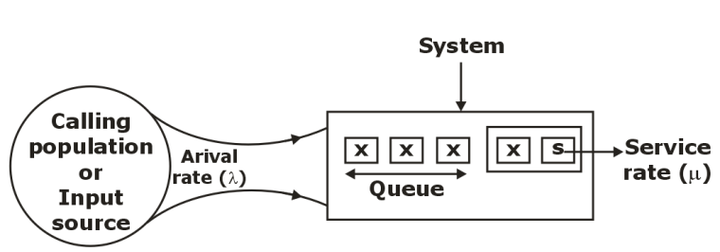- Home/
- GATE MECHANICAL/
- GATE ME/
- Article
Queuing Theory Study Notes for Mechanical Engineering
By BYJU'S Exam Prep
Updated on: September 25th, 2023
QUEUING THEORY
Waiting line theory
The aim of queuing theory is the achievement of economic balance between the cost of providing service and service time.
Table of content
QUEUING THEORY
Waiting line theory
The aim of queuing theory is the achievement of economic balance between the cost of providing service and service time.
Characteristics of queuing model

Arrival rate / Arrival Pattern: The no. of customers arriving per unit time is termed as arrival rate. Customer arrival is random & therefore it is assumed to follow the Poisson distribution.
Service Rate or Service Pattern (μ): The no. of customers serviced per unit time is known as service rate and it is assumed to follow exponential distribution (negative exponential).
Service Rule or Service Order:
It gives information about the queue discipline which means the order by which customers are picked up from the waiting line in order to provide service. E.g.
(1). FIFO or FCFS: First Come first out or First come first served
(2). LCFS: Last come first served
(3). SIRO: Service in random order
(4). Priority treatment.
System and Calling population:
System: It is the place or facilities where the customers arrive in order to get service and its capacity may be finite or infinite.
Calling population: In the entire sample of customers from which few visit the system is termed as calling population.
Customer Attitude
- Jockeying: Customer keeps on changing queue in the hope to get service faster.
- Baulking: Customer does not join the queue & leave the system without joining as the queue is very long.
- Reneging: Customer joins the queue for a short duration & then leave the system as the queue is very slow.
- Cheater: Customer takes illegal means like fighting, bribing, etc. in the hope to get service faster.
Representation of queuing model
Queuing model is represented in Kendall & Lee notation whose general form is
Where a: probability distribution for arrival pattern
b: probability distribution for service pattern
c: no of server within the system
d: service rule or service order
e: size or capacity of the system
f: size or capacity of calling population or input source.
(i) If λ > μ:
Queue length will keep on increasing and after a certain period of time the incoming population will not get serviced. In this condition, we can’t find the solution as the system ultimately fails.
(ii). If λ < μ → System works
λ < μ → prefer
- The ratio of arrival to service rate indicates the % time server is busy it is known as utilization factor or avg. utilization or system utilization or channel efficiency or cleaning ratio.
- It also indicates the probability that a new customer will have to wait.
The probability that the system is idle or Prob. of zero customers in the system.
Probability of having exactly ‘n’ customer in the system
Avg. no. of customers in the system:
In these we include both the customers waiting in the queue along with those getting service.
Avg. no. of customers in the queue
In these, we do not include the customer getting serviced
Avg. waiting time of customers in the queue
The mean waiting time in queue is given by
Avg. waiting time of customers in the system
The mean waiting time in the system is given by
Inter-Arrival Time
The probability density function for Inter arrival time
P(t) = λ . e–λt.
Little’s Law
For a stable system avg, no of customers in the system or queue is given by
Ws: avg. waiting time of customer in the system
Wq: avg. waiting time of customer in the queue.
Some Important Formulae
Avg. length of non-empty queue or Avg. length of queue containing at least one customer
Probability of ‘n’ arrival in the system during period T
Probability that more than T time period is required to service a customer
The probability that the waiting time in the queue is greater than ‘T’
The probability that the waiting time in the system is greater than T
This topic is important for GATE ME, ISRO ME, ESE IES ME, and other Mechanical exams.
If you are preparing for ESE/ GATE or other PSU Exams (Mechanical Engineering), then avail Online Classroom Program for ESE and GATE ME:
Comprehensive Preparation for GATE & ESE ME Exams(500+ Hours of Live Classes, 300+ Quizzes for Practice and 60+ Mock Tests)
You can avail Test Series specially designed for all Mechanical Engineering Exams:
Get Unlimited Access to all 161+ Mock Tests
All the Best!
#DreamStriveSucceed.
Update BYJU’S Exam Prep, Best GATE exam app for Preparation


